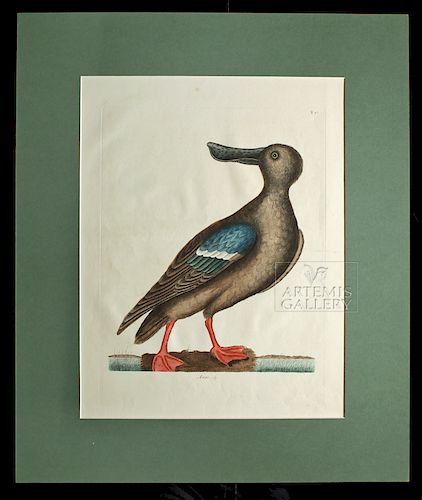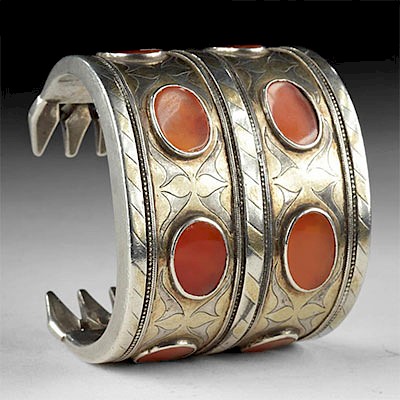Mark Catesby Engraving - "Blue Winged Shoveler" - 1771
Lot 147f
About Seller
Artemis Gallery
686 S Taylor Ave, Ste 106
Louisville, CO 80027
United States
Selling antiquities, ancient and ethnographic art online since 1993, Artemis Gallery specializes in Classical Antiquities (Egyptian, Greek, Roman, Near Eastern), Asian, Pre-Columbian, African / Tribal / Oceanographic art. Our extensive inventory includes pottery, stone, metal, wood, glass and textil...Read more
Estimate:
$1,500 - $2,250
Absentee vs Live bid
Two ways to bid:
- Leave a max absentee bid and the platform will bid on your behalf up to your maximum bid during the live auction.
- Bid live during the auction and your bids will be submitted real-time to the auctioneer.
Bid Increments
| Price | Bid Increment |
|---|---|
| $0 | $25 |
| $300 | $50 |
| $1,000 | $100 |
| $2,000 | $250 |
| $5,000 | $500 |
| $10,000 | $1,000 |
| $20,000 | $2,500 |
| $50,000 | $5,000 |
| $100,000 | $10,000 |
| $200,000 | $20,000 |
About Auction
By Artemis Gallery
Aug 6, 2019
Set Reminder
2019-08-06 11:00:00
2019-08-06 11:00:00
America/New_York
Bidsquare
Bidsquare : VARIETY SALE | Antiquities & Ethnographic Art
https://www.bidsquare.com/auctions/artemis-gallery/variety-sale-antiquities-ethnographic-art-4326
Around the world & back in time - be amazed at the treasures you will find. Antiquities from Egypt, Greece, Italy and the Near East, Asian, Pre-Columbian, African / Tribal / Oceanic, Native American, Spanish Colonial, Russian Icons, Fine Art, much more! All categories, all price ranges... Artemis Gallery info@artemisgallery.com
Around the world & back in time - be amazed at the treasures you will find. Antiquities from Egypt, Greece, Italy and the Near East, Asian, Pre-Columbian, African / Tribal / Oceanic, Native American, Spanish Colonial, Russian Icons, Fine Art, much more! All categories, all price ranges... Artemis Gallery info@artemisgallery.com
- Lot Description
Mark Catesby (British, 1683-1749), "Blue Winged Shoveler", a hand colored, original, copper plate engraving on fine laid paper, from "The Natural History of Carolina, Florida, and the Bahama Islands"; printed in London for Benjamin White, 1771 (Third Edition). A beautiful and scientifically accurate original engraving of the Blue Winged Shoveler (Anas clypeata foemina) - also known as the spoonbill and the northern shoveler - from Catesby's "The Natural History of Carolina, Florida, and the Bahama Islands" - one of the most famous color-plate books illustrating American plant and animal life forms, an original work for the study of various American species. An important work on paper from the most impressive illustrated study of natural history created during the colonial period of America. Indeed many regard Catesby's work as the most significant work of American natural history prior to Audubon's "Birds of America"! Size: sheet measures 20.375" L x 14" W (51.8 cm x 35.6 cm); plate measures 13.75" L x 10.5" W (34.9 cm x 26.7 cm); 21.5" L x 18" W (54.6 cm x 45.7 cm) with mat
The Blue Winged Shoveler (Anas clypeata foemina) - also referred to as spoonbill and the northern shoveler - is oftentimes found in Virginia as well as the Carolinas during the winter months. Its characteristic spatula-shaped bill makes it possible to feed on tiny aquatic flora and fauna, both at the top of the water's surface and below. Catesby, in his accompanying text for this image wrote, "(i)ts bill is three inches long, coal black (though this is of a reddish brown, spotted with black) much broader toward the tip than at the base, excavated like a buckler, of a round circumference. At the end it hath a small crooked hook or nail; each mandible is pectinated or toothed like a comb, with rays or thin plates inserted mutually one into another, when the bill is shut…"
Catesby trained as a botanist, and in 1712 traveled to Virginia where he resided for seven years, all the while sending collections of seeds and plants to London. Encouraged by Sir Hans Sloane and other experts, Catesby returned to America in 1722 where he travelled extensively throughout the Carolinas, Georgia, Florida, and the Bahamas, gathering specimens for his "Natural History". In the preface of his book, Catesby describes his process, including his important decision to study with Joseph Groupy so that he could learn how to engrave his plates in order to guarantee accuracy.
Provenance: private Lucille Lucas collection, Crested Butte, Colorado, USA
All items legal to buy/sell under U.S. Statute covering cultural patrimony Code 2600, CHAPTER 14, and are guaranteed to be as described or your money back.
A Certificate of Authenticity will accompany all winning bids.
We ship worldwide and handle all shipping in-house for your convenience.
#136788Loss and small tears to corners and edges of margins as shown, but these do not interfere with the engraved image. Normal toning to paper and a few minor foxing spots. Strong plate mark. Comes with green mat, but is not attached to mat and can easily be removed.Condition
- Shipping Info
-
All shipping is handled in-house for your convenience. Your invoice from Artemis Gallery will include shipping calculation instructions. If in doubt, please inquire BEFORE bidding for estimated shipping costs for individual items.
-
- Buyer's Premium



 EUR
EUR CAD
CAD AUD
AUD GBP
GBP MXN
MXN HKD
HKD CNY
CNY MYR
MYR SEK
SEK SGD
SGD CHF
CHF THB
THB













